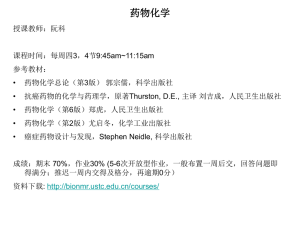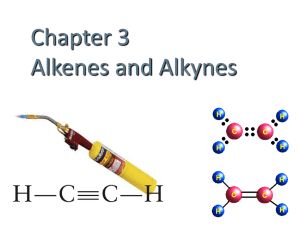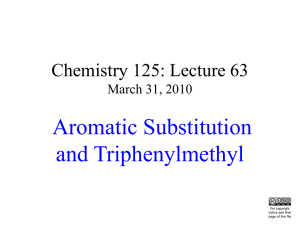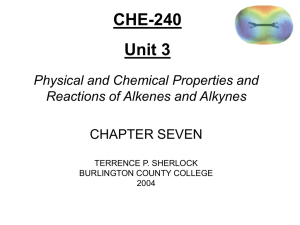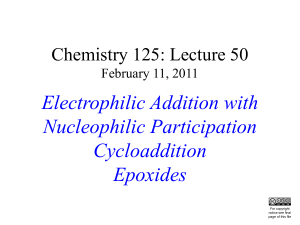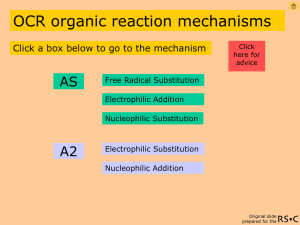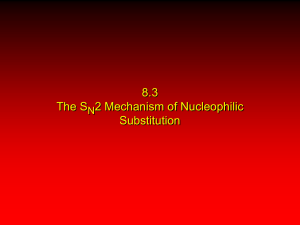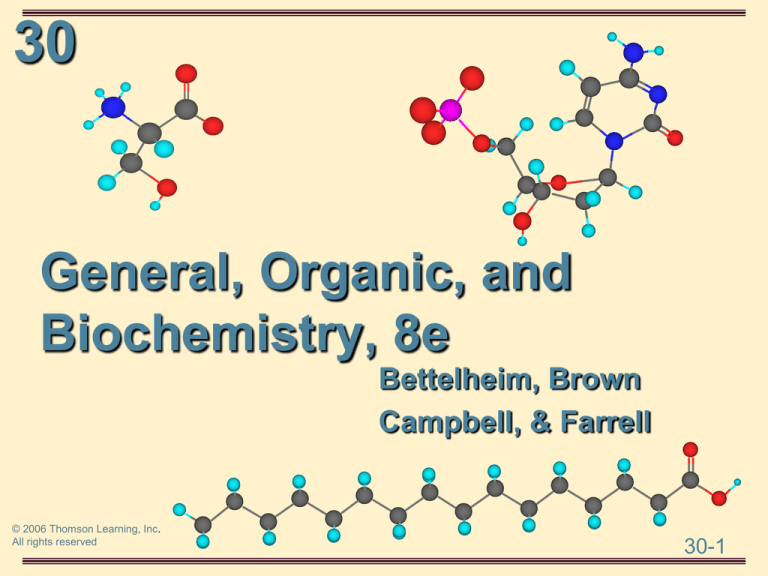
30
General, Organic, and
Biochemistry, 8e
Bettelheim, Brown
Campbell, & Farrell
© 2006 Thomson Learning, Inc.
All rights reserved
30-1
30
Introduction
to Chemistry 32B
Spring 2009
CHAPTER 30
NUTRITION
© 2006 Thomson Learning, Inc.
All rights reserved
30-2
30 Nutrition
• Nutrients: the components of food and drink that
provide growth, replacement, and energy:
1. Carbohydrates
H C
CH
H C
CH
2.
Lipids
H C
3. Proteins
4. Vitamins
Vi am in D
(Promotes C al ciu m an d ph os ph ate
5. Minerals
absorpti on and mobil iz ati on .
6. Water
3
CH3
H3 C CH3
CH3
3
3
CH2 OH
CH3
Vi am in A
Vi si on , to h e al eye
an d s k in i n ju ri es
3
2
CH3
O
CH 3
C
CH 3
CH 3
O
CH3
CH3
CH3
CH3
O
•Digestion: the hydrolysis of starches, fats, and proteins into
Vi tami n E
(An ti oxi dan t)
CH3
smaller units that can be CH
absorbed
and metabolized.
-CH = C- CH
2
© 2006 Thomson Learning, Inc.
All rights reserved
2
O
Vi tami n K
Bl ood cl otti n g)
6
30-3
30 The Food Guide Pyramid
RDA ~ DRI
Dietary
reference
intakes
© 2006 Thomson Learning, Inc.
All rights reserved
30-4
30 The Food Guide Pyramid
© 2006 Thomson Learning, Inc.
All rights reserved
30-5
30 Calories
• Nutritional calorie (Cal): 1000 cal or 1 kcal.
• Basal caloric requirement: the energy
requirement for a resting body.
• ~2900 calories/day for ACTIVE
•~2000 calories/day for sedentary
© 2006 Thomson Learning, Inc.
All rights reserved
30-6
30 Carbohydrates: 4 kcal/g
• Carbohydrates are the main source of energy in a
diet; the main dietary carbohydrates are:
• The polysaccharide starch.
• The disaccharides lactose and sucrose.
• The monosaccharides glucose and fructose.
C6H12O6
Digestion of carbohydrates starts in the mouth:
a-Amylase catalyzes the hydrolysis of a-1,4glycosidic bonds of starch and glycogen.
© 2006 Thomson Learning, Inc.
All rights reserved
30-7
30
Artificial sweeteners
sweet taste~ no calories . ..
•450Xs sweeter
•then Sucrose
© 2006 Thomson Learning, Inc.
All rights reserved
•
100-150Xs sweeter
•then Sucrose
30-8
30 Proteins: 4 kcal/g
• Dietary proteins can be used for energy,
• main use amino acids:
body can synthesize its own proteins.
• Digestion of proteins -- cooking, denatures
• Proteins: HCl stomach hydrolyzes.
• Most protein digestion occurs in the small intestine.
• complete protein: A dietary protein that contains all
essential amino acids. Casein (milk)
© 2006 Thomson Learning, Inc.
All rights reserved
30-9
30 Proteins
• Figure 30.4 Different enzymes catalyze the
hydrolysis of peptide chains at different specific
sites.
© 2006 Thomson Learning, Inc.
All rights reserved
30-10
30 Proteins: not all = complete
• Gelatin, which is denatured collagen, is an incomplete
protein because it lacks Trp, and is low in Ile and Met.
• Corn protein is low in Lys and Trp.
• Rice is low in Lys and Thr.
• Wheat protein is low in Lys.
• Legumes are low in Met and Cys.
Trp
• Soy protein is very low in Met.
Lys
Protein complementation: diet of two or more proteins
complement each other’s deficiencies; for example:
Vegetarians:
1. Rice + tofu
(Japan, China)
2. Corn tortilla + beans
(Central S. America)
© 2006 Thomson
Learning, Inc.
3. Lentils
+ rice
(India)
All rights reserved
30-11
30 Fats: 9 kcal/g
• Fats are the most concentrated source of energy.
• Lipases, enzymes catalyze the hydrolysis of lipids,
• Bile salts, (in liver), emulsify water-insoluble dietary
fats acted upon by lipases.
Which fat is
unsaturated? And why?
Which is solid at room temp?
Which is liq at room temp?
© 2006 Thomson Learning, Inc.
All rights reserved
30-12
30 Vitamins and Minerals
• Fat-Soluble vitamins (Non Polar)
CH3
H3 C CH3
H3 C
H3 C
CH3
CH2 OH
H2 C
CH3
CH3
CH3
Vi am in A
Vi si on , to h e al eye
an d s k in i n ju ri es
Vi am in D
(Promotes C al ciu m an d ph os ph ate
absorpti on and mobil iz ati on .
CH3
HO
CH 3
H3 C
CH 3
CH 3
O
CH3
CH3
CH3
CH3
O
Vi tami n E
(An ti oxi dan t)
CH3
CH2 -CH = C- CH 2
O
6
Vi tami n K
Bl ood cl otti n g)
© 2006 Thomson Learning, Inc.
All rights reserved
30-13
30 Vitamins and Minerals
• Water-Soluble Vitamins (Polar)
O
N
H3 C
N
N
N
S
N
Cl -
N
CH2 OH
N
N
CH2
CH3
B1 (Th iami n e )
(C oen z yme i n oxi dative
de carboxyl ation an d
pe n tos e ph os ph ate s h u n t)
H
COOH
O
N
Ni cotin i c aci d
(Niacin )
C oe n z ym e in
oxidati ve proces s e s)
H C OH
H C OH
H C OH
CH2 OH
S e e Tabl e 30.2
B2 (Ribofl avi n )
B12
(C oen z yme i n oxi dative
(Part of me th yl -re movi n g
proce ss e s ))
e n z ym e in fol ate m etabol is m)
CHO
HO
H3 C
CH2 OH
N
B6 (Pyeri doxal)
(C oen z yme i n
tranLearning,
s am inInc.
ation s ,
© 2006 Thomson
an d h e me s yn th e s is
All rights reserved
H 2N
N
N
N
N
H
N
COOH
O
CNH CH CH 2 CH 2 COOH
OH
Foli c aci d
(C oen z yme i n m e th ylation
an d in DNA s yn th e s is )
30-14
30 Vitamins and Minerals
Mi n e ral
Fu n ction
RDA
Potas si u m
Povi de s me mbran e poten tial
3500 mg
S odiu m
O s motic pres s u re
2000-2400 m g
C al ci u m
Bon e formation ; h orm on al fun ction800-1200
;
mg
blood coagu l ation ; mu s cle con tracti on
C h l ori de ion
O s m oti c pre s su re
1700-5100 m g
Ph osph orus
Balan cin g calci u m i n die t
800-1200 mg
Magn e si u m
C ofactor i n e n z yme s
280-350 mg
Iron
15 mg
Zin c
O xi dative ph osph oryl ati on;
h e moglobin
C ofactor i n e n z yme s; i n su l in
C opper
Man gan es e
C h romiu m
O xi dative e n z ym e s cofactor
Bon e formation
Gl u cos e me tabol is m
1.5-3.0 mg
2.0-5.0 mg
0.05 - 0.2 mg
Mol ybde n u m
C obalt
Prote in syn th e s is
C ompon e n t of vitami n B
12
0.075-0.250 mg
0.05 m g
S e le n i um
Iodi n e
Fat me taboli sm
Th yroi d glan ds
0.05-0.07mg
150-170g
En ame l formati on
1.5-4.0 mg
© 2006 Thomson Learning, Inc.
Flu orin e
All rights reserved
12-15 mg
30-15
FOOD for Performance Enhancement
30
Anthony Almada, BSc, MSc
Cofounder and former CSO
EAS, Pioneering Research
on Creatine
© 2006 Thomson Learning, Inc.
All rights reserved
30-16
30
SUMMARY
Chapter 30-Nutrition
• 1. 6 groups of nutrients:
(Carbs, Fats, Protein, Vitamins, Minerals, water)
•2. Carbohydrates: major source of E in diet
•3. Fats (lipids): have most concentrated Energy: 9 kcal/g
•4. Protein: degraded by body to A.A. specific proteins
5. Deficiency in Vit./minerals nutritional diseases:
(Vit A – bad night vision)
(Vit C –scurvy)
Vegetarians (B vitamins, folic acid) –
anemia
CHECK OUT NUTRITION CLASS (F.C.S.19-Nutrition),
© 2006 Thomson Learning, Inc.
All rights reserved
Sharon Antonelli
30-17
30
GOAL of TODAY
• Expose to basics or organic molecular structure:
Carbohydrates(starch)
Tri-glycerides (fats)
CH3
H3 C CH3
H3 C
H3 C
CH3
CH2 OH
CH3
CH3
H2 C
CH3
Vi am in A
Vitamin
A
Vi si on , to h e al eye
an d s k in i n ju ri es
Vi am in D
(Promotes C al ciu m an d ph os ph ate
absorpti on and mobil iz ati on .
Amino acids
CH3
O
CH 3
CH 3
CH 3
O
CH3
CH3
CH3
CH3
O
Vi tami n E
(An ti oxi dan t)
© 2006 Thomson Learning, Inc.
All rights reserved
CH3
CH2 -CH = C- CH 2
O
Vi tami n K
Bl ood cl otti n g)
6
30-18
30
Introduction to Chemistry 32B - Spring 2009
FOR WEDNESDAY
PLEASE READ
Week of
Page No. in Text
(Wed) 1/28
70-83
269-282
Chapter, WS, & Lab
3
10
Topics
Chemical bonds (Review)
Organic Chemistry
Updated Syllabus
CH3
H3 C CH3
CH3
CH2 OH
CH3
Vi am in A
Vi si on , to h e al eye
an d s k in i n ju ri es
Text: General, Organic and Biochemistry, Bettelheim, Brown and
CH3 March, 7th ed. 2004,
HO
Thomson-Brookes/Cole:
CH 3
CH 3
CH 3
H3 C
© 2006 Thomson Learning, Inc.
All rights reserved
O
CH3
30-19
Vi tami n E
(An ti oxi dan t)
C


